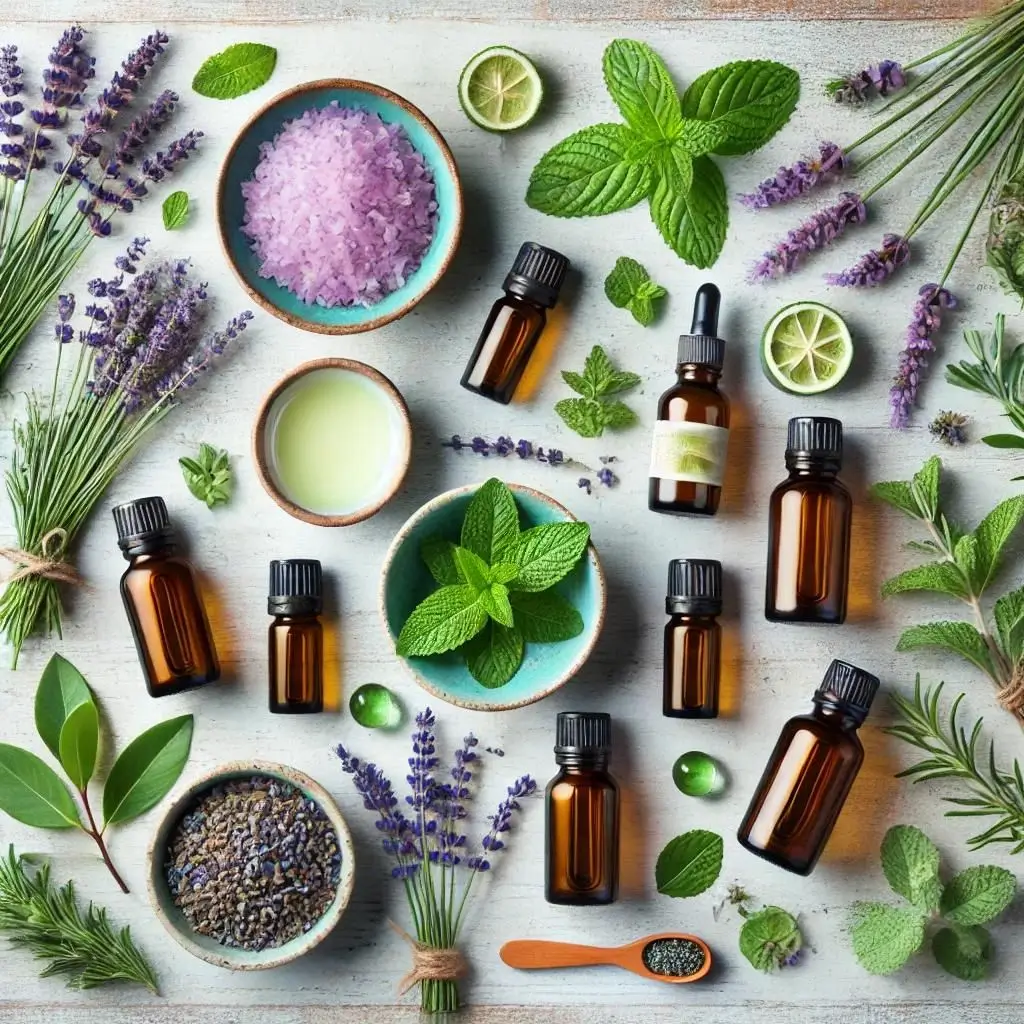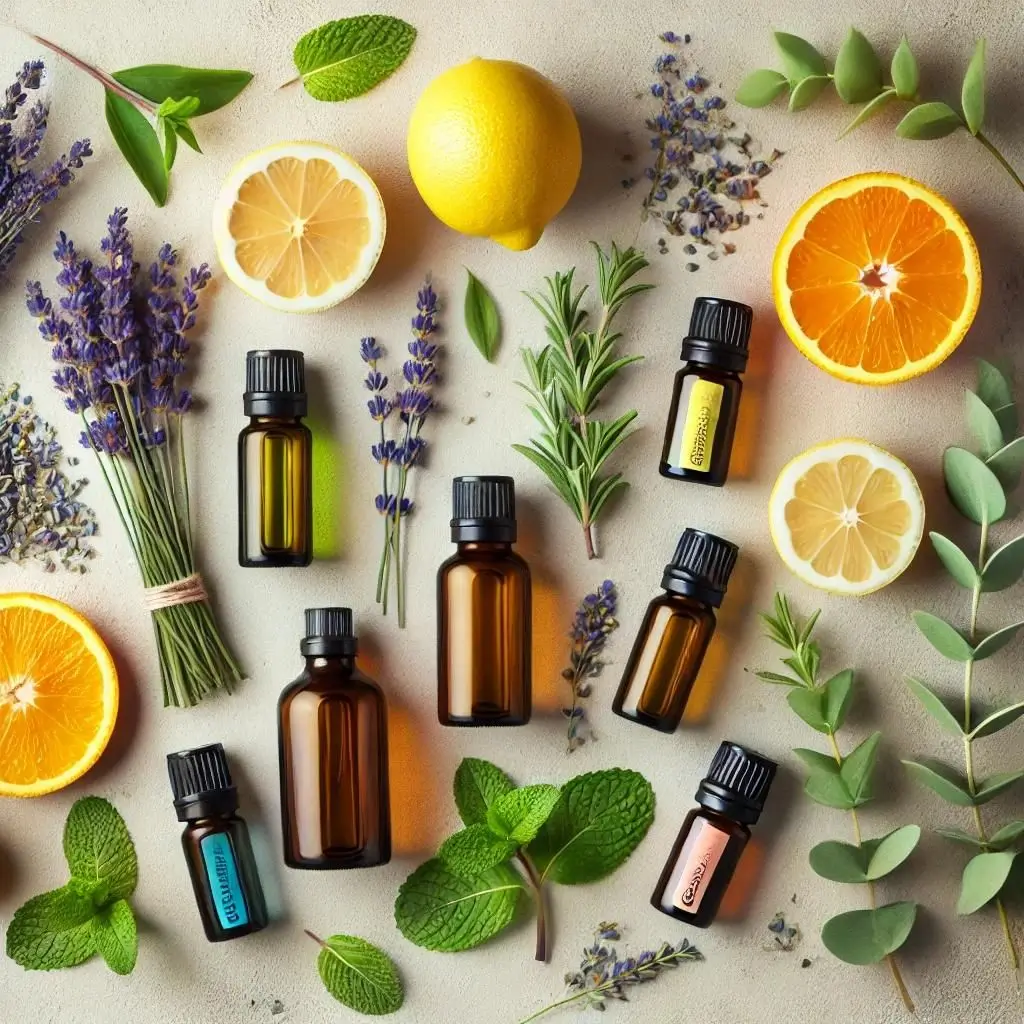Swollen lymph nodes, often a sign that the body is fighting an infection, can be uncomfortable and sometimes painful. Essential oils have become a popular remedy to help alleviate the symptoms associated with swollen lymph nodes, thanks to their anti-inflammatory and soothing properties. When applied properly, essential oils can support lymphatic drainage and reduce swelling. In this guide, we will explore the best essential oils to use for swollen lymph nodes, how to use them safely, and the potential benefits they offer.
What essential oils are good for swollen lymph nodes?
Several essential oils are known for their potential benefits in reducing inflammation and supporting the lymphatic system. Here are some of the most effective ones:
- Tea Tree Oil: Known for its antimicrobial properties, tea tree oil can help fight infections that may be causing lymph node swelling.
- Lavender Oil: Lavender is renowned for its calming effects and anti-inflammatory properties, making it a gentle option for lymph node care.
- Eucalyptus Oil: This oil is known for its ability to boost immunity and reduce inflammation, which can be helpful in managing swollen lymph nodes.
- Peppermint Oil: With its cooling sensation, peppermint oil can relieve pain and reduce swelling in the lymphatic system.
- Lemon Oil: Lemon essential oil is a natural detoxifier and can help stimulate lymphatic drainage.
- Frankincense Oil: Known for its anti-inflammatory properties, frankincense can help reduce swelling and improve lymphatic flow.
- Rosemary Oil: Rosemary has been used to support circulation and reduce swelling, which can be beneficial for lymph nodes.
- Ginger Oil: Its warming effect can help increase circulation and reduce swelling.
Table of Essential Oils and Their Benefits
| Essential Oil | Benefits |
|---|---|
| Tea Tree | Antimicrobial, fights infection |
| Lavender | Calming, anti-inflammatory |
| Eucalyptus | Boosts immunity, reduces inflammation |
| Peppermint | Cooling, pain relief |
| Lemon | Detoxifier, stimulates drainage |
| Frankincense | Reduces swelling, improves flow |
| Rosemary | Supports circulation, reduces swelling |
| Ginger | Increases circulation, reduces swelling |
How do essential oils help with swollen lymph nodes?
Essential oils can support the lymphatic system and help with swollen lymph nodes in several ways. First, many essential oils possess anti-inflammatory properties, which can help reduce the swelling and discomfort associated with swollen lymph nodes. Oils such as lavender and frankincense are particularly effective in this regard.
Secondly, essential oils like eucalyptus and tea tree have antimicrobial properties that can help fight infections causing the lymph nodes to swell. By addressing the root cause of the swelling, these oils can promote faster recovery.
Essential oils can also enhance lymphatic drainage, helping to clear toxins and reduce congestion in the lymphatic system. Oils like lemon and rosemary are particularly beneficial for stimulating lymphatic flow and promoting detoxification.
Additionally, essential oils can provide soothing and analgesic effects, helping to alleviate pain and discomfort associated with swollen lymph nodes. Peppermint oil is known for its cooling sensation and pain-relieving properties.
Overall, essential oils can offer a natural and holistic approach to managing swollen lymph nodes, supporting the body’s natural healing processes and providing relief from symptoms.

How can you use essential oils for swollen lymph nodes?
Using essential oils for swollen lymph nodes involves various application methods to maximize their benefits. Here are some effective ways to use essential oils for this purpose:
- Topical Application: Dilute a few drops of your chosen essential oil with a carrier oil (such as coconut or jojoba oil) and gently massage the mixture onto the affected area. This helps the oils penetrate the skin and reach the lymph nodes.
- Lymphatic Drainage Massage: Perform a gentle lymphatic drainage massage using diluted essential oils to stimulate lymphatic flow and reduce swelling. This involves applying light pressure in circular motions towards the heart.
- Compress: Create a warm or cool compress by soaking a clean cloth in water mixed with a few drops of essential oil. Apply the compress to the swollen lymph nodes for soothing relief.
- Aromatherapy: Use an essential oil diffuser to disperse the oils into the air. Inhaling the aromatic molecules can help relax the body and support the immune system.
- Bath Soak: Add a few drops of essential oil to a warm bath and soak in it for 15–20 minutes. This method allows the oils to be absorbed through the skin and provides overall relaxation.
- Steam Inhalation: Boil water, add a few drops of essential oil, and inhale the steam. This can help clear congestion and promote respiratory health.
- Foot Bath: Soak your feet in warm water with a few drops of essential oil. This can help promote relaxation and lymphatic circulation.
- Compress with Carrier Oil: Mix a few drops of essential oil with a carrier oil, apply it to a cloth, and use it as a compress on the affected area.
- Body Lotion: Add essential oils to your daily body lotion for ongoing support and soothing effects.
- Neck Rub: Apply diluted essential oil to the neck area and gently massage to reduce tension and promote lymphatic flow.
Remember to always perform a patch test before using essential oils on a larger area and consult with a healthcare professional if you have any concerns or specific medical conditions.
Are there any safety precautions to consider when using essential oils for swollen lymph nodes?
When using essential oils for swollen lymph nodes, it is important to follow certain safety precautions to ensure their safe and effective use:
- Dilution: Always dilute essential oils with a carrier oil before applying them to the skin. Undiluted oils can cause skin irritation and sensitivity.
- Patch Test: Perform a patch test on a small area of skin to check for any adverse reactions before applying essential oils to larger areas.
- Avoid Sensitive Areas: Avoid applying essential oils near sensitive areas such as the eyes, ears, and mucous membranes.
- Use Caution with Children and Pets: Some essential oils may not be safe for use on children or pets. Research and consult with a healthcare professional before using essential oils around them.
- Allergies: If you have allergies, be cautious when using essential oils. Some oils may trigger allergic reactions, so it’s important to know your sensitivities.
- Pregnancy and Nursing: Pregnant or nursing women should consult with a healthcare professional before using essential oils, as certain oils may not be safe during these periods.
- Sun Sensitivity: Some essential oils, such as citrus oils, can increase sensitivity to sunlight. Avoid sun exposure after applying these oils to the skin.
- Medical Conditions: If you have any underlying medical conditions or are taking medications, consult with a healthcare professional before using essential oils to ensure they won’t interfere with your treatment.
- Storage: Store essential oils in a cool, dark place to maintain their potency and prevent degradation.
- Quality: Choose high-quality, pure essential oils from reputable brands to ensure their safety and effectiveness.
By following these safety precautions, you can enjoy the benefits of essential oils for swollen lymph nodes while minimizing the risk of adverse effects.
What are the symptoms of swollen lymph nodes that might benefit from essential oils?
Swollen lymph nodes can manifest with various symptoms, and essential oils may offer relief for some of these symptoms. Here are common symptoms associated with swollen lymph nodes that might benefit from essential oil use:
- Pain or Tenderness: Swollen lymph nodes can be painful or tender to the touch. Essential oils with analgesic properties, such as peppermint and lavender, can help alleviate pain and discomfort.
- Swelling: The primary symptom of swollen lymph nodes is noticeable swelling in the affected area. Essential oils with anti-inflammatory properties, such as frankincense and tea tree oil, can help reduce swelling.
- Redness or Warmth: Swollen lymph nodes may appear red or feel warm. Essential oils with cooling effects, such as eucalyptus and peppermint, can provide soothing relief.
- Fatigue: The body’s immune response to an infection can lead to fatigue. Essential oils with invigorating properties, such as rosemary and lemon, can help boost energy levels and combat fatigue.
- Fever: In some cases, swollen lymph nodes may be accompanied by a fever. Essential oils like eucalyptus and tea tree can support the immune system and aid in reducing fever.
- Sore Throat: Swollen lymph nodes in the neck can lead to a sore throat. Essential oils like lavender and tea tree can offer soothing effects and promote throat comfort.
- Congestion: Swollen lymph nodes may cause congestion and difficulty breathing. Essential oils such as eucalyptus and peppermint can help clear nasal passages and promote respiratory health.
- Muscle Aches: Infections causing swollen lymph nodes may lead to muscle aches. Essential oils with analgesic properties, such as lavender and ginger, can help relieve muscle discomfort.
- Chills: Essential oils with warming effects, such as ginger and frankincense, can help combat chills and promote comfort.
- Stress and Anxiety: Swollen lymph nodes can cause stress and anxiety. Essential oils with calming properties, such as lavender and chamomile, can help promote relaxation and emotional well-being.
While essential oils can offer relief for some symptoms associated with swollen lymph nodes, it’s important to address the underlying cause and seek medical attention if necessary.
How do you dilute essential oils for use on swollen lymph nodes?
Proper dilution of essential oils is essential to ensure their safe and effective use for swollen lymph nodes. Here are steps to dilute essential oils for topical application:
- Choose a Carrier Oil: Select a carrier oil to dilute the essential oil. Common carrier oils include coconut oil, jojoba oil, almond oil, and olive oil. These oils help carry the essential oil to the skin and reduce the risk of irritation.
- Determine the Dilution Ratio: The dilution ratio depends on the intended use and the user’s skin sensitivity. A general guideline is to use a 1–3% dilution for adults, which equates to 1–3 drops of essential oil per teaspoon (5 mL) of carrier oil.
- Mix the Oils: In a small glass container, combine the chosen essential oil(s) with the carrier oil, ensuring thorough mixing. This ensures the essential oil is evenly distributed in the carrier oil.
- Perform a Patch Test: Before applying the diluted oil to a larger area, perform a patch test on a small area of skin to check for any adverse reactions. Wait 24 hours to ensure no irritation occurs.
- Adjust the Dilution if Necessary: If the patch test reveals sensitivity, consider further diluting the mixture by adding more carrier oil.
- Store Properly: Store the diluted oil in a dark glass bottle to maintain its potency and prevent degradation. Label the bottle with the essential oils used and the date of preparation.
- Application: Apply the diluted oil to the affected area using gentle, circular motions. This promotes absorption and enhances the effects of the essential oils.
- Avoid Sensitive Areas: Avoid applying the diluted oil to sensitive areas such as the eyes, mouth, and open wounds.
- Frequency: Use the diluted oil as needed, typically 1–3 times a day, depending on the severity of the symptoms.
- Consult a Professional: If you are unsure about the dilution process or have specific health concerns, consult a qualified aromatherapist or healthcare professional for personalized guidance.
By following these steps, you can safely and effectively use diluted essential oils to support lymphatic health and manage swollen lymph nodes.
Can essential oils be used for lymphatic drainage massage?
Yes, essential oils can be used in lymphatic drainage massage to support the lymphatic system and promote detoxification. Lymphatic drainage massage is a gentle technique that encourages the flow of lymph fluid, helping to remove toxins and reduce swelling. Here’s how essential oils can enhance this massage technique:
- Choose the Right Oils: Select essential oils known for their lymphatic-supporting properties, such as lemon, grapefruit, ginger, and cypress. These oils can stimulate lymphatic flow and enhance the detoxification process.
- Dilute the Oils: Dilute the chosen essential oils with a carrier oil to create a massage blend. A 2% dilution (10–12 drops of essential oil per ounce of carrier oil) is typically suitable for massage.
- Prepare the Area: Ensure the massage area is clean and comfortable. Use a soft towel or blanket to support relaxation during the massage.
- Apply the Oil: Apply the diluted essential oil blend to the skin using gentle, upward strokes. Focus on areas with lymph nodes, such as the neck, underarms, and groin, as well as areas where swelling occurs.
- Use Gentle Pressure: Lymphatic drainage massage involves using light pressure to encourage lymph flow. Avoid pressing too hard, as this can impede the natural movement of lymphatic fluid.
- Follow Lymphatic Pathways: Massage in the direction of lymphatic pathways, moving towards the heart. This helps guide the lymph fluid towards the lymph nodes for processing and elimination.
- Focus on Relaxation: Encourage relaxation by incorporating breathing techniques and calming music during the massage. Relaxation can enhance the effectiveness of the massage.
- Stay Hydrated: After the massage, drink plenty of water to help flush out toxins and support the lymphatic system’s natural detoxification process.
- Consistency: Regular lymphatic drainage massage with essential oils can provide ongoing support for lymphatic health. Consider incorporating it into your wellness routine.
- Consult a Professional: If you are new to lymphatic drainage massage or have specific health concerns, consider consulting a trained massage therapist for guidance and support.
By incorporating essential oils into lymphatic drainage massage, you can enhance the benefits of this technique and support the body’s natural detoxification processes.
Which essential oils are best for lymphatic drainage?
Essential oils can play a significant role in promoting lymphatic drainage and supporting the lymphatic system. Here are some of the best essential oils for lymphatic drainage:
- Lemon Oil: Lemon essential oil is known for its detoxifying properties and ability to stimulate lymphatic flow. It helps clear toxins and supports the body’s natural cleansing processes.
- Grapefruit Oil: Grapefruit oil is a natural diuretic and lymphatic stimulant, making it effective for reducing fluid retention and promoting lymphatic circulation.
- Cypress Oil: Cypress oil has astringent properties that help tighten and strengthen blood vessels, supporting lymphatic drainage and reducing swelling.
- Ginger Oil: Ginger oil’s warming effects can enhance circulation and promote lymphatic flow, aiding in the removal of toxins and reducing inflammation.
- Geranium Oil: Geranium oil is known for its balancing effects on the lymphatic system, promoting detoxification and reducing fluid retention.
- Juniper Berry Oil: Juniper berry oil is a powerful detoxifier and diuretic, helping to eliminate excess fluids and promote lymphatic drainage.
- Peppermint Oil: Peppermint oil’s cooling properties can relieve discomfort and support lymphatic flow, making it an excellent choice for swollen lymph nodes.
- Basil Oil: Basil oil is known for its ability to stimulate circulation and lymphatic flow, reducing congestion and promoting detoxification.
- Frankincense Oil: Frankincense oil supports the immune system and enhances lymphatic function, promoting overall wellness and detoxification.
- Rosemary Oil: Rosemary oil improves circulation and lymphatic flow, supporting the body’s natural detoxification processes.
Table of Essential Oils for Lymphatic Drainage
| Essential Oil | Benefits for Lymphatic Drainage |
|---|---|
| Lemon | Detoxifying, stimulates lymphatic flow |
| Grapefruit | Diuretic, reduces fluid retention |
| Cypress | Astringent, strengthens blood vessels |
| Ginger | Warming, enhances circulation |
| Geranium | Balancing, reduces fluid retention |
| Juniper Berry | Detoxifier, promotes drainage |
| Peppermint | Cooling, supports lymphatic flow |
| Basil | Stimulates circulation, reduces congestion |
| Frankincense | Supports immunity, enhances lymphatic function |
| Rosemary | Improves circulation, supports detoxification |
These essential oils can be used individually or in combination to create blends for lymphatic drainage massage or topical application. By incorporating these oils into your wellness routine, you can support the lymphatic system and promote detoxification.
What are some recipes for essential oil blends for swollen lymph nodes?
Creating essential oil blends for swollen lymph nodes can enhance their therapeutic effects and provide relief from symptoms. Here are some simple recipes to try:
Soothing Blend
Ingredients:
- 3 drops of lavender oil
- 2 drops of frankincense oil
- 2 drops of peppermint oil
- 1 tablespoon of carrier oil (such as coconut or jojoba oil)
Instructions:
- In a small glass bottle, combine the lavender, frankincense, and peppermint oils.
- Add the carrier oil and shake gently to mix.
- Apply the blend to the affected area using gentle circular motions.
Detoxifying Blend
Ingredients:
- 3 drops of lemon oil
- 3 drops of grapefruit oil
- 2 drops of ginger oil
- 1 tablespoon of carrier oil
Instructions:
- Combine the lemon, grapefruit, and ginger oils in a glass container.
- Add the carrier oil and mix well.
- Use the blend for a lymphatic drainage massage or apply it topically to swollen lymph nodes.
Anti-Inflammatory Blend
Ingredients:
- 4 drops of tea tree oil
- 3 drops of eucalyptus oil
- 2 drops of rosemary oil
- 1 tablespoon of carrier oil
Instructions:
- Mix the tea tree, eucalyptus, and rosemary oils in a small bottle.
- Add the carrier oil and shake to combine.
- Apply the blend to the affected area, focusing on lymph nodes and swollen areas.
Relaxing Blend
Ingredients:
- 3 drops of chamomile oil
- 3 drops of lavender oil
- 2 drops of geranium oil
- 1 tablespoon of carrier oil
Instructions:
- Combine the chamomile, lavender, and geranium oils in a glass bottle.
- Add the carrier oil and mix thoroughly.
- Use the blend for a soothing massage or apply it topically to promote relaxation and reduce swelling.
Cooling Blend
Ingredients:
- 3 drops of peppermint oil
- 3 drops of basil oil
- 2 drops of juniper berry oil
- 1 tablespoon of carrier oil
Instructions:
- Mix the peppermint, basil, and juniper berry oils in a glass container.
- Add the carrier oil and shake well.
- Apply the blend to swollen lymph nodes for a cooling and soothing effect.
When creating essential oil blends, always perform a patch test to check for any adverse reactions and adjust the dilution ratio as needed for your skin type and sensitivity.
Are there any side effects of using essential oils on swollen lymph nodes?
While essential oils can offer numerous benefits for swollen lymph nodes, it’s important to be aware of potential side effects and take necessary precautions. Here are some potential side effects to consider:
- Skin Irritation: Some essential oils may cause skin irritation or allergic reactions, especially if used undiluted. Always perform a patch test before applying oils to a larger area.
- Sensitivity: Certain individuals may have sensitivities to specific essential oils, leading to redness, itching, or rash. If you experience any of these symptoms, discontinue use and seek medical advice.
- Photosensitivity: Some essential oils, particularly citrus oils like lemon and grapefruit, can increase sensitivity to sunlight and cause sunburn. Avoid sun exposure after applying these oils to the skin.
- Respiratory Irritation: Inhaling certain essential oils in high concentrations may cause respiratory irritation or discomfort. Use essential oils in moderation and ensure proper ventilation when diffusing.
- Hormonal Effects: Some essential oils, such as clary sage and fennel, may have hormonal effects and should be used with caution by individuals with hormonal imbalances or conditions.
- Pregnancy and Nursing: Pregnant or nursing women should consult with a healthcare professional before using essential oils, as certain oils may not be safe during these periods.
- Drug Interactions: Essential oils may interact with medications or medical conditions. Consult with a healthcare professional if you have any underlying health concerns or are taking medications.
- Toxicity: Some essential oils can be toxic if ingested. Keep essential oils out of reach of children and pets and avoid internal use unless under the guidance of a qualified professional.
- Eye Irritation: Essential oils can cause severe irritation if they come into contact with the eyes. In case of contact, rinse thoroughly with water and seek medical attention if necessary.
- Overuse: Using essential oils excessively can lead to adverse effects or sensitization. Use essential oils in moderation and follow recommended guidelines for dilution and application.
By being aware of these potential side effects and taking necessary precautions, you can safely enjoy the benefits of essential oils for swollen lymph nodes and overall well-being.
Conclusion
Essential oils offer a natural and holistic approach to managing swollen lymph nodes, providing relief from symptoms and supporting the lymphatic system. With their anti-inflammatory, antimicrobial, and soothing properties, essential oils can help reduce swelling, alleviate pain, and promote detoxification. By incorporating essential oils into your wellness routine, you can enhance lymphatic health and support the body’s natural healing processes. Always remember to use essential oils safely, perform patch tests, and consult with a healthcare professional if you have any concerns or specific medical conditions.



